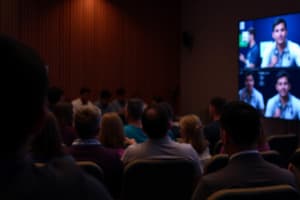Podcast
Questions and Answers
What is the primary focus of the content provided?
What is the primary focus of the content provided?
- Discussion of various artistic movements
- Detailed scientific experiment results
- General exploration of unspecified topics (correct)
- Analysis of historical events
Which of the following best describes the structure of the content?
Which of the following best describes the structure of the content?
- A cohesive narrative
- Disjointed segments with no clear connection (correct)
- Sequential chapters with defined headings
- A list of bullet points
What can be inferred about the intended audience of the content?
What can be inferred about the intended audience of the content?
- Experts in a specific field
- Individuals seeking detailed technical information
- Students focused on a specific curriculum
- General readers with no prior knowledge (correct)
Which of the following statements is most likely true regarding the content?
Which of the following statements is most likely true regarding the content?
What aspect of the content might challenge reader comprehension?
What aspect of the content might challenge reader comprehension?
Flashcards are hidden until you start studying
Study Notes
Range of Motion (ROM)
- Range of motion is the amount of movement possible at a joint in certain directions
- It's a technique used for movement examination (goniometry) and to initiate therapeutic interventions.
Physical and Physiological Considerations Related to Joint ROM
- Intrinsic Factors:
- Shape and congruency of articulating bony surfaces
- Pliability of the joint capsule, ligaments, and other collagenous tissues
- Strength and flexibility of musculature acting on or crossing the joint.
- Extrinsic Factors:
- Aging can decrease joint ROM
- Body segment size is related to muscle or adipose tissue bulk.
- Effects of disease, injury, overuse, and immobilization on joint tissues and ROM
Types of ROM Exercises
- Passive ROM (PROM): Movement of a body segment within the unrestricted ROM, entirely by an external force without voluntary muscle contraction.
- Sources of external force include gravity, machines (Continuous Passive Motion - CPM), another individual, or another part of the individual's body.
- Manual: Therapist or unaffected part of the body
- Mechanical: CPM device
- Active ROM (AROM): Movements performed within the unrestricted ROM controlled by voluntary muscle contraction.
- Types of active movements include free exercise, assisted exercise, and resisted exercise.
- Active-Assistive ROM (A-AROM): Movement performed within the unrestricted ROM controlled by voluntary muscle contraction, with assistance from an outside force (manual or mechanical) when muscle strength is inadequate to complete the motion.
Uses of Passive Range of Motion
- Relaxed Passive Movement: Used to maintain full range of motion without restriction.
- Passive Movement for Mobilization: Used to breakdown adhesions and increase range of motion.
- Passive Movement for Stretching: Used to lengthen pathologically shortened soft tissues to increase joint range.
Indications of Passive Range of Motion
- Coma
- Paralysis
- Immobilized joint
- Muscle re-education (teaching patient desired movement)
- Used before passive stretching technique
- Examination
Goals for Passive ROM
- Decrease complications of immobilization (cartilage degeneration, adhesions, contracture formation, sluggish circulation)
- Maintain joint and connective tissue mobility
- Minimize contracture formation
- Maintain mechanical elasticity of muscle
- Assist in circulation & vascular dynamics
- Enhance synovial movement for cartilage nutrition
- Decrease or inhibit pain
- Assist with the healing process after injury or surgery
- Maintain patient awareness of movement
Limitations of Passive ROM
- Does not prevent muscle atrophy
- Does not increase strength or endurance
- Does not assist circulation to the same extent as active muscle contraction
Precautions and Contraindications to PROM Exercises
- When motion disrupts healing process (unhealed fracture, open wound)
- When excessive or inappropriate motion increases pain and inflammation
- At the site of effusion and swelling
- Immediately after ligament or tendon tear
- Uncontrolled high blood pressure
Principles and Procedures for Applying ROM Techniques
- Examination, Evaluation, and Treatment Planning:
- History taking (from patient, relatives)
- General examination (active ROM, passive ROM, muscle strength)
- Select appropriate techniques (AROM, PROM, AAROM)
- Monitoring the patient:
- Response to exercise (before and after)
- Vital signs
- Pain, ROM, and quality of movement
- Warmth and color of segment
- Document and communicate findings and intervention: Comprehensive documentation and communication are critical for effective treatment planning and care.
- Re-evaluation: Re-evaluate and modify the intervention as necessary.
Patient Preparation
- Communicate with the patient
- Free the region from restrictive clothing, linen, splints, and dressings
- Cover other parts
- Position patient comfortably with proper alignment and stabilization
- Position yourself for proper body mechanics
Application of Techniques
- Control movement by grasping extremity proximal and distal to the affected joint; grasp should be firm but not harmful.
- Support areas with poor structural integrity (like hypermobile joints, recent fracture sites, paralyzed limbs)
- Move the segment through the complete pain-free range to the point of tissue resistance.
- Perform the motions smoothly and rhythmically
- Use 5-10 repetitions (number depends on treatment objectives, patient condition, and response to treatment)
Characteristics of Relaxed Passive Movement
- Slowly
- Rhythmically
- Regular
- Through full range of motion (available)
Continuous Passive Motion (CPM)
- CPM refers to passive motion performed by a mechanical device that moves a joint slowly and continuously through a controlled ROM.
Benefits of CPM
- Prevents development of adhesions and contractures, joint stiffness
- Stimulates tendon and ligament healing
- Enhances incision healing & synovial fluid lubrication (increasing cartilage healing)
- Prevents degrading effects of immobilization
- Quickens return of ROM
- Decreases postoperative pain
Active Movement
- Movements performed within the unrestricted ROM controlled by voluntary muscle contraction.
Classification of Active Movement
- Free Exercise: Working muscles are subjected only to forces of gravity acting on the part moved.
- Assisted Exercise: Muscle strength is inadequate; an external force (manual or mechanical) is applied to compensate for the movement.
- Resisted Exercise: Forces of resistance are manually or mechanically increased to strengthen/increase endurance of the muscles.
Definition of AAROM
- Movement performed within the unrestricted ROM controlled by voluntary muscle contraction with assistance from an outside force (manual or mechanical) when muscle strength is inadequate to complete the motion.
- Muscle strength is less than grade 3 by manual muscle testing.
- Once patients gain control of their ROM, they are progressed to AROM.
Principles of Active Assisted Exercises
- Voluntary muscle contraction is insufficient to produce or control movement.
- An external force may be applied to complete the range
- Apply the external force in the direction of the muscle contraction.
- Assist the muscular action, don't act as a substitute.
- As the muscular power increases, the assistance should decrease proportionally.
Types of Assistance
- Mechanical: Equipment like wands, T-bars, finger ladders, wall climbing, ball rolling, pulleys, skateboards, reciprocal exercise devices
- Manual: Therapist or patient's unaffected limb
Effects and Uses of AAROM
- Used for patients with weakness (not paralysis)
- Maintains physiologic elasticity and contractility of participating muscles.
- Provides sensory feedback for neuromuscular re-education.
- Provides bone and joint integrity stimulus.
- Develops coordination and motor skills for functional activities.
- Increases patient confidence
- Prevents DVT
- Improves blood circulation
- Can increase metabolism to help lose weight.
- Reduces risk of heart disease & heart attack by improving blood pressure and cholesterol levels.
Contraindications of AAROM
- Gross swelling, fever, redness
- Immediately after myocardial infarction
- Acute, intolerable pain during movement
- Cardiopulmonary dysfunction
- Unhealed/unprotected recent fractures or surgical sites/acute tears
- Cases of DVT
Indications of AAROM
- Muscle weakness due to disuse or after plaster casts
- Muscle re-education
- Inability to perform activities of daily living (ADLs)
- To increase ROM
- Following tendon or muscle transplantation
Precautions for ROM Exercises
- Proximal and distal exercises to injured/immobilized joints minimize venous and thrombus formation.
Technique of Assisted Exercise
- Starting position: Ensure patient attention and effort
- Pattern of movement: Explain to patient; perform passively or actively on unaffected limb.
- Fixation: Fixate proximal part of prime movers to improve efficiency; avoid trick movements.
- Support: Support moved part to reduce load on muscle; use pillows, boards, slings, or provider's hand. Support should be in appropriate plane and adjustable through the range; eliminate force or load on weak muscle by counterbalancing.
- Traction: Preliminary stretching of weak muscle stimulates muscle spindle.
- Antagonistic muscle: Choose starting position to reduce tension on antagonistic muscles (example: knee flexion for dorsiflexion).
- Assistance force: Applied in movement direction; varies depending on range. Mostly needed at beginning and end of movement to overcome inertia
- Character of the movement: Smoothly performed and efficient with patient's focus
- Repetitions: Determined by patient condition and rate of fatigue
- Patient cooperation: Essential to achieve controlled active movement without assistance; encourage maximum effort.
Active Free Exercise (AROM)
- Performed by patient's own muscular efforts within unrestricted ROM without assistance or resistance.
- Categorized as localized (strengthening muscle groups) or generalized (using many muscles).
Principles of Active Free Exercises
- Relaxation: Exercises that are rhythmic or pendulum-like.
- Joint mobility: Maintain range of joint motion by full range exercises.
- Power and endurance: Of working muscles.
- Co-ordination
- Confidence
- Circulatory and respiratory cooperation: Increased respiration produces heat to increase circulation
Goals for AROM
- Maintain physiologic elasticity and contractility.
- Provide sensory feedback.
- Provide stimulus for bone and joint integrity.
- Increase circulation and prevent thrombus formation.
- Develop coordination.
Technique of Active Free Exercises
- Selected and taught starting position for maximum posture and efficiency.
- Instructions to gain patient interest and cooperation.
- The speed depends on the effect required.
- The duration depends on the patient's capacity without fatigue.
- Demonstrate the desired movement using PROM, have hands in position to guide if needed.
Passive versus Active ROM
- Passive ROM: Only ligamentous/joint capsule structures are stressed. If injured, pain will likely result.; mover muscles are not stressed.
- Active ROM: Both mover muscles and the ligament/joint capsule are stressed; moving the joint leads to stretching/compression to various parts if injured areas are present. Pain is likely to result if injury is present.
- Active ROM is useful as a screening procedure for soft tissue injuries or dysfunction.
- Manual Resistance: only mover musculature is stressed; isometric contractions; no movement occurs; pain results if injury is present.
- Ligaments and joint capsule are not stressed because the joint does not move; not stressed or compressed.
Effects of Immobilization
- Fractures, surgery, paralysis, spasticity, arthritic conditions, pain lead to complications with extended immobilization.
- Loss of bone density (due to inactivity)
- Reduced articular cartilage thickness and stiffness
- Collagen tissue fibrosis and adhesion
- Muscle tissue atrophy and contracture. (slow-twitch fibers more affected than fast-twitch)
Studying That Suits You
Use AI to generate personalized quizzes and flashcards to suit your learning preferences.




